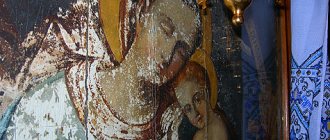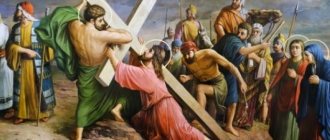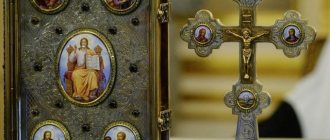Recently, while reading about the Apostles on a popular Christian website, I accidentally came across a list of possible deaths for each of them. I already knew that many of Christ’s Apostles died brutal deaths, but I was still shocked by some of the details. Out of curiosity, I did my own research on the same topic and I want to share it below.
WARNING: The circumstances of their deaths are quite difficult to comprehend, so be prepared. Additionally, many details about apostolic deaths are not included in the Bible's narrative. Many became known thanks to superficial historical, apocryphal and similar sources. I can provide links to these sources, but I would not be surprised if a couple of details are not entirely accurate. Fair warning.
Andrey (Peter's brother)
Andrew is not often mentioned in the Bible, and there is even less information about the circumstances of his death. But here's what National Geographic says about it:
“According to 15th-century religious historian Dorman Newman, Andrew, Peter's brother, went to Patras in Western Greece in 69 AD. e., where the Roman proconsul Egates discussed religion with him. Egates tried to convince Andrei to renounce Christianity so that he would not have to torture and execute him. But when that didn't work, it's obvious he decided to punish him to the fullest. Andrei was scourged and then tied, rather than nailed to a cross, so that he would suffer for a long time before dying. Andrei lived for two days, during which he preached to passers-by.”
The only apostle the Bible speaks of dying is the apostle James (Acts 12:2). King Herod killed James with a sword - probably referring to beheading. The circumstances of the death of the other apostles can only be known from church traditions, which are not as reliable as Holy Scripture. The most common church tradition regarding the death of the apostles is that the Apostle Peter was crucified upside down in Rome, in fulfillment of the prophecy of Jesus (John 21:18). Below are also the most reliable legends about the death of other apostles.
Matthew was tortured in Ethiopia and killed by the sword. John met martyrdom by being thrown into a huge cauldron of boiling oil during persecution in Rome. However, he narrowly escaped death and was exiled to the mines of the island of Patmos. There he wrote his prophetic book of Revelation. He was later released and returned to what is now modern Turkey. He died of old age - this is the only apostle who died a natural death.
James, the brother of Jesus (an unofficial apostle) who led the church in Jerusalem, was thrown from the southeast wing of the temple (from a height of over thirty meters) when he refused to renounce his faith in Christ. When his enemies discovered that he had survived the fall, they beat him to death. This was the same wing of the temple where Satan brought Jesus during his temptation.
Bartholomew, also known as Nathanael, was a missionary to Asia. He preached in Turkey and died for his faith in Armenia from being beaten with whips. Andrew was crucified in Greece. After beating seven soldiers, his body was tied to a cross with ropes to prolong his agony. His followers reported that when he was led to the crucifixion, Andrew greeted the cross with the following words: “I have been waiting for this joyful hour for a long time! The cross was consecrated when the body of Christ hung on it.” He continued preaching to his tormentors for two days until he died. The Apostle Thomas was stabbed to death with a spear in India during one of his missionary journeys. Matthew, chosen as an apostle to replace the traitor Judas Iscariot, was stoned and then beheaded. The Apostle Paul was tortured and then beheaded by order of Emperor Nero in Rome in 67 AD. Traditions regarding other apostles have also been preserved, but they do not have reliable historical evidence.
It is not so important how the apostles died. The important fact is that they were all ready to die for their faith. If Jesus had not been resurrected, the disciples would certainly have known this. No one will go to death for what is a lie. The fact that all the apostles were willing to die horribly by refusing to renounce their faith in Christ is the greatest proof that they were indeed witnesses to the resurrection of Jesus Christ.
John the Revelator (also known as John the Beloved)
Traditional Christian understanding implies that John the Beloved died of natural causes on the island of Patmos, where he lived in exile. However, according to Latter-day Saint beliefs, we rely on section 7 of the Doctrine and Covenants:
“And the Lord said to me: John, my beloved, what do you desire? For if you ask, whatever you desire will be given to you. And I said to Him: Lord, give me power over death, so that I can live and lead souls to You. And the Lord said to me: “Truly, truly, I say to you, because you have willed this, you will remain until I come in My glory, and you will prophesy before nations, tribes, tongues and peoples.”
So John is simply somewhere nearby, continuing to preach the Gospel.
How the apostles of Jesus Christ died
The only apostle the Bible speaks of dying is the apostle James (Acts 12:2).
King Herod killed James with a sword—probably referring to beheading. The circumstances of the death of the other apostles can only be known from church traditions, which are not as reliable as Holy Scripture. The most common church tradition regarding the death of the apostles is that the Apostle Kephas (Peter) was crucified upside down in Rome, in fulfillment of the prophecy of Christ (John 21:18) . Below are also the most reliable legends about the death of other apostles.
Peter - during the persecution of Nero, he was crucified on an inverted cross in 64, upside down. The latter was at the apostle’s own request, since Peter considered himself unworthy to die exactly the same death as the Messiah.
Andrew - crucified in Greece. After being beaten by seven soldiers, his body was tied to a cross with ropes to prolong the agony. The followers of the apostle reported that when he was led to the crucifixion, Andrew greeted the cross with these words: “I have long been expecting this joyful hour. The cross was consecrated when the Body of the Messiah hung on it.” He continued preaching to his tormentors for two days until he died.
Matthew - was tortured in Ethiopia and killed by the sword.
John - met martyrdom when he was boiled in a huge cauldron of boiling oil during persecution in Rome. However, he miraculously escaped death and was sentenced to prison on the island of Patmos. He lived to old age - the only apostle who died a natural death.
Jacob , son of Alphaeus - in the Egyptian city of Ostratsina, Saint James martyrically completed his apostolic labors by death on the cross. He was beheaded.
Philip - for his preaching activities he was executed (crucified upside down) in 87 (during the reign of the Roman Emperor Domitian) in the city of Hierapolis in Asia Minor.
Simeon - crucified.
Thaddeus - killed by shooters.
James , the brother of Jesus (an unofficial apostle) who led the church in Jerusalem, was thrown from the southeast wing of the temple (from a height of over thirty meters) when he refused to renounce his faith in Christ. When his enemies discovered that he had survived the fall, they beat him to death. This was the same wing of the temple where Satan brought Jesus during his temptation.
Thomas - pierced by spears in India.
Bartholomew th - crucified in Armenia.
James , son of Zebedee - Acts also reports his death: in 44, King Herod Agrippa I “killed James, the brother of John, with the sword.”
It is not so important how the apostles died. The important fact is that they were all ready to die for their faith. If Jesus had not been resurrected, the disciples would certainly have known this. No one will go to death for what is a lie. The fact that all the apostles were willing to die horribly by refusing to renounce their faith in Christ is the greatest proof that they were indeed witnesses to the resurrection of Jesus Christ.
PS How are you “dying” for the Lord today?..
Source: istina.info - How the apostles of Jesus Christ died
Bartholomew (also known as Nathanael)
Very little is known about Bartholomew's death. Some sources simply say that he was tortured, others that he was flayed alive and beheaded. One source says he was "slashed with knives." "Cut up" can imply simply having his skin mutilated, but also the removal of skin due to tearing or beating. Indeed, another hypothesis suggests that the severe beating tore Bartholomew's skin "to shreds." The common theme among the various theories is that, regardless of the cause, it was a terrible death.
Photo Fun Interesting
How did the apostles of Jesus Christ die?
The Bible says that Jesus was crucified on the cross and died a martyr for the sins of man. And even atheists know about this. But not everyone knows that almost all of his students were killed violently. In fact, only the Apostle John escaped torture and died a natural death. What happened to the others?
1. Crucifixion
Jesus
The Savior was not the only one crucified. This type of execution was often used by the Romans. In addition to Jesus, three of his disciples were killed by crucifixion - Philip, Thaddeus and Simon the Canaanite.
2. Crucifix upside down
Peter
The Apostle Peter was also sentenced to death by crucifixion. Unlike a regular crucifixion, Peter was crucified upside down (some sources claim that Philip was crucified the same way). It is believed that this was done because Peter refused to die in the same way as Jesus, since "he was just a disciple and was not worthy to die like his teacher."
The very idea that the executioners allowed the victim to choose how he would be executed is, to put it mildly, controversial. Historical records neither prove nor disprove this. However, it is generally accepted in Christian circles that the decision to crucify Peter upside down was made because he asked for it. Unlike traditional crucifixion, in which the victim usually dies from asphyxiation, Peter's death was most likely caused more quickly by a cerebral hemorrhage.
3. Bind to the Cross
Andrey
Apostle Andrew was crucified. He was severely scourged as this was the usual practice of "preparing the victim for execution." However, Andrei was not nailed to the cross, but tied to it. Unlike Jesus, who died after six hours of suffering, Andrew remained alive on the cross for more than two days, suffering all the same pains caused by the crucifixion, minus the pain and bleeding from the puncture wounds.
4. Decapitation
Jacob Zebedee
Beheading is a public execution and a quick death for the victim. Although science still doesn't know exactly how long a person feels something after beheading, it is believed that consciousness remains for several seconds after the execution. The disciple executed by beheading was James Zebedee.
The most unusual thing about his death is not how he died, but the fact that the person who brought him to the chopping block died with him. Someone falsely accused Jacob of breaking the law. This accusation led to the apostle's death penalty. However, Jacob is said to have been so courageous before his execution that his accuser repented of his false accusations, became a believer in Christianity, and asked to be beheaded along with Jacob. The executioners cut off both heads at the same time.
5. Skin removal
Bartholomew
Bartholomew died in terrible agony. First, they skinned him (and this is already enough to die from painful shock), and then they also beheaded him. Most likely, by the time his head was cut off, he was dead, and this terrible act should have become a public intimidation.
6. Spear Strike
Thomas
One of the students lived for several more days until his vital organs, pierced by a spear, completely failed. This student's name was Thomas. Typically, a puncture wound can cause death due to blood loss over time. However, with Thomas it was different. After the death of Jesus, he went to preach Christianity in India (and today in this country there are “Christians of the Apostle Thomas”), where he received several blows in the chest with a spear.
A piece of the iron spearhead broke off and remained in his body. As a result, Thomas did not die from blood loss, but from the fact that this tip remained in his chest cavity, which pierced his lungs, pierced his heart and tore his liver.
7. Stab
Matthew
The Apostle Matthew was stabbed in the back (however, in various sources there are versions that Matthew was burned, stoned to death, or beheaded). If we consider the first version, then he lost consciousness and died from loss of blood. Most likely, with such a wound, his lungs or kidneys were damaged. One way or another, his death was slower than Thomas' death from the spear.
8. Stoning
Jacob Alfeev
Jesus had two disciples named James. Jacob Zebedee was already mentioned above, who was beheaded, and the other was the son of Alphaeus. Jacob Alfeev was stoned. When it turned out that he had survived, he was finished off by breaking his skull with a thick wooden stick.
In fact, a person may experience seizures, paralysis, and altered consciousness as a result of a traumatic brain injury. However, given the damage to Jacob's body, the effects of traumatic brain injury may not have been the primary cause of death. He may have had convulsions and Jacob lost consciousness, dying from a combination of blood loss.
9. Suicide by hanging
Judas Iscariot
One of Jesus' most famous disciples, Judas Iscariot, also died a violent death. The only difference was that Judas was not killed for his beliefs, but he committed suicide by hanging himself. Hanging can result in a quick loss of consciousness or can be a terribly long and painful process. This depends on whether the person's neck is broken after a fall (when the stand is knocked out from under his feet).
If the neck is broken, the victim loses consciousness within seconds. However, if it does not break, the person hangs and suffocates for a period of time before losing consciousness. In either case, death usually occurs within 5-20 minutes. It is unknown whether Judas' neck was broken or not.
10. Sawing in half
students
The Bible mentions another way in which Jesus' disciples (not among the 12 apostles) were killed - sawing a living person in half. The executioners, as a rule, sawed open the victim's groin area and left him to die in agony.
Of all the disciples of Christ, only John escaped violent death. He was exiled to an island, where he lived to a ripe old age. By the way, there was also a 13th student in history who was “appointed” to replace Judas Iscariot - his name is Matthias. But his death is not recorded in history.
See also:
The most terrible mushroom in the world: "Devil's fingers"
The coolest railway station in Russia
Matthew (tax collector)
One Christian website states that Matthew “became a missionary and was captured in Ethiopia. It was there that he was impaled or speared, and then beheaded. Beyond this, little is known, as Matthew was in a remote place in Africa where not many historians or Christians have ventured.”
National Geographic offers a slightly different version that, according to legend, Matthew was "stabbed in the back by a sword-bearer (in Ethiopia) sent by King Gertak after he criticized the king's morals."
Who was Judas Jacob, aka Levway Thaddeus?
Church Tradition has long believed that he was one of the “brothers of the Lord according to the flesh.” This is the customary name for the children from the first marriage of the righteous Joseph, the named father of Jesus Christ, betrothed to the Virgin Mary. Or - according to another version - his nephews, whom Joseph adopted. We know the names of these “brothers” of Jesus thanks to the evangelists Mark and Matthew: James, Josiah, Judas and Simon. And the Gospel of John tells us that at first the brothers did not believe in Him as the Son of God (John 7 :5). Over time, however, Judas believed and entered the inner circle of the apostles: one of the first to express this guess was Blessed Jerome of Stridon (ⱡ about 420), who lived for many years in Palestine and scrupulously studied the Hebrew text of the Bible and local traditions. And another “brother of the Lord” in the flesh, Jacob, after the Ascension of the Savior, even led the Christian community of Jerusalem.
Judas Jacob, apostle; Byzantium; XII century; location: Greece. Athos
In the 19th and 20th centuries, attempts were made to challenge the assumption that the Apostle Jude James was the “brother of the Lord.” Some Western researchers have noticed that in the Gospel the “brothers of the Lord” are mentioned everywhere along with the apostles, but never among them. Many believed that the remark of John the Theologian about the brothers who did not believe in Him applied to the entire time of the Lord’s earthly life. They also wrote that the nickname “Jacob”, in accordance with tradition, should have indicated Judah’s father rather than his brother. However, this argument is not the strongest, given that in the Catholic Epistle of the Holy Apostle Jude he himself introduces himself as the brother of James (Jude 1:1).
One way or another, the Church accepted the opinion of Blessed Jerome as completely justified, and since then Church Tradition confidently calls the Apostle Judas “brother of the Lord.”
James (not John's brother)
Theory 1: Jacob was crucified during his ministry in Egypt (keep in mind that the source for this is Wikipedia. So, as you can imagine, take this with a grain of salt).
Theory 2: Jacob "died as a martyr and his body was sawn apart."
Theory 3: As an old man, he was beaten, stoned, and eventually killed with a club to the head.
Theory 4: Jacob was preaching on the wall when the Jewish religious leaders decided to throw him down. Apparently he survived, so, like the third theory, he was stoned and clubbed to death.
Does the Bible contain accounts of the death of the apostles? How did the apostles die?
Answer
The only apostle the Bible speaks of dying is the apostle James (Acts 12:2). King Herod killed James with a sword - probably referring to beheading. The circumstances of the death of the other apostles can only be known from church traditions, which are not as reliable as Holy Scripture. The most common church tradition regarding the death of the apostles is that the Apostle Peter was crucified upside down in Rome, in fulfillment of the prophecy of Jesus (John 21:18). Below are also the most reliable legends about the death of other apostles.
Matthew was tortured in Ethiopia and killed by the sword. John met martyrdom by being thrown into a huge cauldron of boiling oil during persecution in Rome. However, he narrowly escaped death and was exiled to the mines of the island of Patmos. There he wrote his prophetic book of Revelation. He was later released and returned to what is now modern Turkey. He died of old age - this is the only apostle who died a natural death.
James, the brother of Jesus (an unofficial apostle) who led the church in Jerusalem, was thrown from the southeast wing of the temple (from a height of over thirty meters) when he refused to renounce his faith in Christ. When his enemies discovered that he had survived the fall, they beat him to death. This was the same wing of the temple where Satan brought Jesus during his temptation.
Bartholomew, also known as Nathanael, was a missionary to Asia. He preached in Turkey and died for his faith in Armenia from being beaten with whips. Andrew was crucified in Greece. After beating seven soldiers, his body was tied to a cross with ropes to prolong his agony. His followers reported that when he was led to the crucifixion, Andrew greeted the cross with the following words: “I have been waiting for this joyful hour for a long time! The cross was consecrated when the body of Christ hung on it.” He continued preaching to his tormentors for two days until he died. The Apostle Thomas was stabbed to death with a spear in India during one of his missionary journeys. Matthew, chosen as an apostle to replace the traitor Judas Iscariot, was stoned and then beheaded. The Apostle Paul was tortured and then beheaded by order of Emperor Nero in Rome in 67 AD. Traditions regarding other apostles have also been preserved, but they do not have reliable historical evidence.
It is not so important how the apostles died. The important fact is that they were all ready to die for their faith. If Jesus had not been resurrected, the disciples would certainly have known this. No one will go to death for what is a lie. The fact that all the apostles were willing to die horribly by refusing to renounce their faith in Christ is the greatest proof that they were indeed witnesses to the resurrection of Jesus Christ.
Judas Iscariot
The Bible helps us in this story too. Matthew 27:3-5 says:
“Then Judas, who had betrayed Him, saw that He was condemned and, repenting, returned the thirty pieces of silver to the chief priests and elders, saying: I have sinned by betraying innocent blood. They said to him: What is that to us? take a look yourself. And, throwing away the pieces of silver in the temple, he went out, went and hanged himself.”
But Acts 1:16-19 paints a very different picture of his death:
“Men and brethren! It was necessary to fulfill what the Holy Spirit foretold in the Scriptures through the mouth of David about Judas, the former leader of those who took Jesus; he was numbered among us and received the lot of this ministry; but he acquired the land with an unrighteous bribe, and when he fell down, his belly was split open and all his entrails fell out; and this became known to all the inhabitants of Jerusalem, so that the land in their native dialect was called Akeldama, that is, the land of blood.”
I think in the Mormon faith we are more used to the hanging theory, but who knows. In the end, it doesn't really matter.
The only apostle who died a natural death
Evangelist John the Theologian was born in 1-11 after the Nativity of Christ in Bethsaida. He was a fisherman, like his father. But John’s mother, Solomiya, is one of the myrrh-bearing women who came early in the morning to the tomb of the already risen Christ.
Photo 1. John on the island of Patmos. Hieronymus Bosch, 1504-1505
Together with Peter and James, he witnessed the resurrection of Jairus' daughter. Only them Jesus made witnesses of his Transfiguration and prayer in the Garden of Gethsemane. Jesus sent only John and Peter into the city to prepare for the last Passover Vespers.
After the Resurrection of Christ, John began his preaching in Ephesus. During the persecution of Christians, he was exiled and lived for many years on the island of Patmos, where, according to legend, he wrote his Revelation.
He lived a long life preaching the teachings of Christ, and died at the age of over a hundred years in Ephesus.
Monastery of St. John the Evangelist on the island of Patmos
Features of the Gospel
Unlike the other evangelists, who wrote as Jews, the gospel of John was written by a Christian. It has a completely different structure of the text; it is already a conceptual text. The weather forecasters present many events as facts, but John always processes the text, making it obedient to a specific idea. This was largely done for the sake of polemics with the Gnostics, who interpreted the Gospel events in their own way. In the conversation with the Samaritan woman, this is clearly visible. There, Jesus opens the theme of living water, which is further developed and supplemented in other episodes: about false water in the sheep's pool, which could not save the paralytic, and then in a polemic with the disciples of John the Baptist about true baptism. In general, the text of the Gospel speaks no more about miracles, signs and events, but about Christ himself. As individuals.
Papyrus 52, with an excerpt from the Gospel of John in ancient Greek, is the oldest surviving manuscript of the New Testament
Text problems
The Gospel of John is the best preserved of all four. But it is the preservation of the text that gives rise to one problem - out of 878 verses, almost every third has variants of reading and translation. For example, in In. 1:34 you can find options: “Son of God” and “Chosen of God”, and in John. 1:18: “Only Begotten God” and “Only Begotten Son”, which, in principle, changes the meaning of what is read. And the story about the woman who, according to the law of Moses, wanted to be executed for adultery, is not at all in manuscripts until the fourth century.
"In the beginning was the Word..."
“In the beginning was the Word, and the Word was with God, and the Word was God. It was in the beginning with God. All things came into being through Him, and without Him nothing began to be that was made” (John 1:1-3). These words are familiar to every Christian—the Gospel of John begins with them. It is worth saying that these words do not belong to the one who wrote the subsequent chapters of the Gospel. Perhaps this is a kind of Christian hymn, a kind of symbol of faith, suitable in spirit to the subsequent text, which is why it was included there. Interestingly, depending on who these words were written to, the text can change its meaning:
— For people with a biblical mindset, the “Word” is just “implied.” That is, the author says that the one we are going to talk about now is God, who lived with us as a person.
— For people with a Greek-pagan mindset, “The Word” is a reference to the logos of Heraclitus. This is a general law that gives order to nature. In this case, the prologue says that this is not an impersonal law, but God, to whom the evangelist testifies.
Epistles from John
There are three epistles in our Bible that are traditionally attributed to John. The first talks about false prophets who corrupt the Christian community, who do not recognize that Christ was a man, or who do not recognize Him at all. Perhaps this only refers to the nascent Gnostics, who speak of certain knowledge that completely changes the understanding of the life and mission of Christ. The second and third messages also speak of difficulties within the communities, both due to new teachings that do not correspond to the spirit of the gospel, and to the problems associated with the disappearance of the Jerusalem community after the destruction of the city by the Romans.
Interesting Facts
— The symbol of the Evangelist John is an eagle. The eagle depicts the theological heights of the teaching in the Gospel of John and the divine mysteries it conveys.
— Artistically and symbolically, John is depicted at a venerable age, in a red robe, with an inkwell, a pen and a book in his hands and in the presence of an angel, often an eagle; sometimes presented as young, beardless and long-haired.
— Tradition says that when the time came to depart to the Lord, the Apostle John asked his disciples to dig a grave for him outside Ephesus and bury him alive, covering his face with a cloth. The disciples did not dare to disobey John. Some time later, when the grave was opened, John’s body was not there. But every year, on May 21, a thin layer of dust (or “manna”) began to appear on the grave, bringing healing. In honor of this, a spring celebration of the memory of the Apostle was established.
Priest Alexander KOLATSKY
Now you know
It is interesting to learn a little more about how the Apostles of Christ died, but what has much more eternal significance is to study what they did and taught throughout their lives. The Letters of Peter, the Gospels of Matthew and St. John, etc.. That's where the good stuff is. If you have not yet taken the time to study the lives of these people and the Master Whom they served, I would encourage you to do so.
The original article was published on Mormon Hub. By David Snell. Translator Elena Shannon.
Translation
The only apostle the Bible speaks of dying is the apostle James (Acts 12:2). King Herod killed James with a sword - probably referring to beheading. The circumstances of the death of the other apostles can only be known from church traditions, which are not as reliable as Holy Scripture. The most common church tradition regarding the death of the apostles is that the Apostle Kepha (Peter) was crucified upside down in Rome, in fulfillment of the prophecy of Yeshua (John 21:18). Below are also the most reliable legends about the death of other apostles.
- Peter - during the persecution of Nero, He was crucified on an inverted cross in 64, upside down. The latter was at the apostle’s own request, since Peter considered himself unworthy to die exactly the same death as Mashiach.
- Andrew - crucified in Greece. After beating seven soldiers, his body was tied to a cross with ropes to prolong his agony. His followers reported that as he was being led to the crucifixion, Andrew greeted the cross with the following words: “I have long awaited this joyful hour. The cross was consecrated when the Body of the Messiah hung on it." He continued preaching to his tormentors for two days until he died.
- Matthew - was tortured in Ethiopia and killed by the sword.
- John - met martyrdom when he was boiled in a huge cauldron of boiling oil during persecution in Rome. However, he miraculously escaped death and was sentenced to prison on the island of Patmos. He died in old age, the only apostle who died a natural death.
- Jacob, son of Alphaeus - in the Egyptian city of Ostratsina, Saint James martyrically completed his apostolic labors by death on the cross. He was beheaded.
- Philip - for his preaching activities he was executed (crucified head down) in 87 (during the reign of the Roman Emperor Domitian) in the city of Hierapolis in Asia Minor.
- Simeon - crucified.
- Thaddeus - killed by shooters.
- Jacob, Yeshua's brother, was thrown more than a hundred feet down from the southeast wing of the temple when he refused to renounce his faith in Christ. When it was discovered that he had survived the fall, he was stoned to death.
- Thomas - pierced by spears in India.
- Bartholomew - crucified in Armenia.
- James, son of Zebedee - Acts also reports his death: in 44, King Herod Agrippa I “killed James, the brother of John, with the sword.”
holy-mozart.livejournal.com
Follow site updates on social networks:
Facebook, Twitter, VKontakte
Support the portal www.MirVam.org
GD Star Rating loading…
GD Star Rating loading…
Share on social media networks
RќСЂР°РІРёС‚СЃСЏ
Facebook comments:
Related posts:
A nail from the crucifixion of Jesus Christ was found
Archaeologists have discovered in the Milevsky Monastery in the South Bohemian Region of the Czech Republic a part of a metal nail, presumably a nail from the cross on which Jesus Christ was crucified. An ancient relic was found in a niche in the monastery wall. Let us know about this…
Voice of the Martyrs Korea released a video in memory of a Christian lawyer
On the occasion of the second anniversary of the death of Chinese Christian lawyer Li Baiguang, Voice of Martyrs Korea (VOMC) released a video containing a song with lyrics from Isaiah 35. He recorded and sang the song while riding a bus for several...
Despite the Risk, Muslims in the Gaza Strip Receive Christ – Voice of the Martyrs
On June 2, the Voice of the Martyrs ministry spoke about the preaching of the Gospel and the life of Christians in the Gaza Strip. A Voice of the Martyrs staff member working in the West Bank and Gaza Strip asked for prayer for Christian converts from Islam...
A former North Korean officer spoke about how he accepted Christ and began helping refugees
A former North Korean military officer who carried out executions spoke about how he accepted Christ and began helping refugees. 64-year-old Kim Yong Hwa spoke at the 16th annual North Korea Freedom Week event in Washington DC dedicated to…
A Christian was kidnapped and killed in India for refusing to convert to Hinduism.
Anantram Gondi, a farmer from Odisha, India, was recently killed for refusing to convert to Hinduism. This was discussed in the Voice of the Martyrs ministry on April 22. He and his wife Sukbati came to faith in Christ in 2018 and were active in their church. ...
Note.
When using site materials, a hyperlink to www.mirvam.org is required. Use of materials in print media only after written permission from the editor.
How did the apostles of Jesus Christ die? 10 Methods of Execution Described in the Bible
The Bible says that Jesus was crucified on the cross and died a martyr for the sins of man. And even atheists know about this. But not everyone knows that almost all of his students were killed violently. In fact, only the Apostle John escaped torture and died a natural death. What happened to the others?
1. Crucifixion
Jesus
The Savior was not the only one crucified. This type of execution was often used by the Romans. In addition to Jesus, three of his disciples were killed by crucifixion - Philip, Thaddeus and Simon the Canaanite.
2. Crucifix upside down
Peter
The Apostle Peter was also sentenced to death by crucifixion. Unlike a regular crucifixion, Peter was crucified upside down (some sources claim that Philip was crucified the same way). It is believed that this was done because Peter refused to die in the same way as Jesus, since "he was just a disciple and was not worthy to die like his teacher."
The very idea that the executioners allowed the victim to choose how he would be executed is, to put it mildly, controversial. Historical records neither prove nor disprove this. However, it is generally accepted in Christian circles that the decision to crucify Peter upside down was made because he asked for it. Unlike traditional crucifixion, in which the victim usually dies from asphyxiation, Peter's death was most likely caused more quickly by a cerebral hemorrhage.
3. Bind to the Cross
Andrey
Apostle Andrew was crucified. He was severely scourged as this was a common practice of "preparing the victim for execution." However, Andrei was not nailed to the cross, but tied to it. Unlike Jesus, who died after six hours of suffering, Andrew remained alive on the cross for more than two days, suffering all the same pains caused by the crucifixion, minus the pain and bleeding from the puncture wounds.
4. Decapitation
Jacob Zebedee
Beheading is a public execution and a quick death for the victim. Although science still doesn't know exactly how long a person feels something after beheading, it is believed that consciousness remains for several seconds after the execution. The disciple executed by beheading was James Zebedee.
The most unusual thing about his death is not how he died, but that the person who brought him to the chopping block died with him. Someone falsely accused Jacob of breaking the law. This accusation led to the apostle's death penalty. However, Jacob is said to have been so courageous before his execution that his accuser repented of his false accusations, became a believer in Christianity, and asked to be beheaded along with Jacob. The executioners cut off both heads at the same time.
5. Skin removal
Bartholomew
Bartholomew died in terrible agony. First, they skinned him (and this is already enough to die from painful shock), and then they also beheaded him. Most likely, by the time his head was cut off, he was dead, and this terrible act should have become a public intimidation.
6. Spear Strike
Thomas
One of the students lived for several more days until his vital organs, pierced by a spear, completely failed. This student's name was Thomas. Typically, a puncture wound can cause death due to blood loss over time. However, with Thomas it was different. After the death of Jesus, he went to preach Christianity in India (and today in this country there are “Christians of the Apostle Thomas”), where he received several blows in the chest with a spear.
A piece of the iron spearhead broke off and remained in his body. As a result, Thomas did not die from blood loss, but from the fact that this tip remained in his chest cavity, which pierced his lungs, pierced his heart and tore his liver.
7. Stab
Matthew
The Apostle Matthew was stabbed in the back (however, in various sources there are versions that Matthew was burned, stoned to death, or beheaded). If we consider the first version, then he lost consciousness and died from loss of blood. Most likely, with such a wound, his lungs or kidneys were damaged. One way or another, his death was slower than Thomas' death from the spear.
8. Stoning
Jacob Alfeev
Jesus had two disciples named James. Jacob Zebedee was already mentioned above, who was beheaded, and the other was the son of Alphaeus. Jacob Alfeev was stoned. When it turned out that he had survived, he was finished off by breaking his skull with a thick wooden stick.
In fact, a person may experience seizures, paralysis, and altered consciousness as a result of a traumatic brain injury. However, given the damage to Jacob's body, the effects of traumatic brain injury may not have been the primary cause of death. He may have had convulsions and Jacob lost consciousness, dying from a combination of blood loss.
9. Suicide by hanging
Judas Iscariot
One of Jesus' most famous disciples, Judas Iscariot, also died a violent death. The only difference was that Judas was not killed for his beliefs, but he committed suicide by hanging himself. Hanging can result in a quick loss of consciousness or can be a terribly long and painful process. This depends on whether the person's neck is broken after a fall (when the stand is knocked out from under his feet).
If the neck is broken, the victim loses consciousness within seconds. However, if it does not break, the person hangs and suffocates for a period of time before losing consciousness. In either case, death usually occurs within 5-20 minutes. It is unknown whether Judas' neck was broken or not.
10. Sawing in half
students
The Bible mentions another way in which Jesus' disciples (not among the 12 apostles) were killed - sawing a living person in half. The executioners, as a rule, sawed open the victim's groin area and left him to die in agony.
Of all the disciples of Christ, only John escaped violent death. He was exiled to an island, where he lived to a ripe old age. By the way, there was a 13th student in history who was “appointed” to replace Judas Iscariot - his name is Matthias. But his death is not recorded in history.
source







